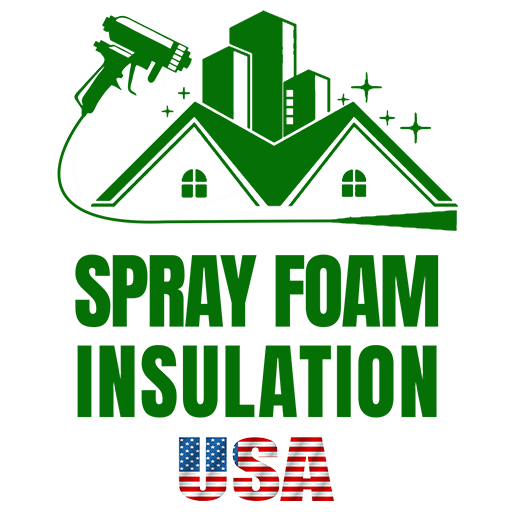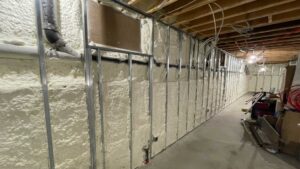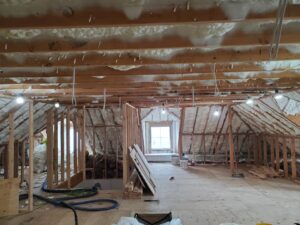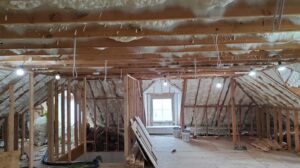Introduction
How to insulate an attic door effectively starts with understanding the significance of proper attic door insulation. A well-insulated attic door prevents air leaks which can lead to substantial energy cost savings, enhanced indoor comfort throughout the year, and more controlled temperature fluctuations which prevent long-term damage to the structure of your home.
Insulating your attic door is crucial because it’s one of the most common places where air leaks occur in a home. When warm air escapes in the winter or cool air in the summer, your heating and cooling system has to work harder, increasing your energy bills and potentially leading to discomfort in living spaces.
While the task may seem daunting, the right knowledge and materials will streamline the process, making it a worthwhile weekend project for any homeowner looking to boost their home’s energy efficiency and comfort. Here are some simple yet effective DIY steps:
- Check for air leaks and install weather stripping.
- Add insulation panels to the attic door, either in the form of fiberglass or rigid foam board.
- Ensure a snug fit and seal any remaining gaps with caulk or expandable foam.

Understanding these basic steps not only helps in reducing energy consumption but also supports your effort towards a more sustainable living environment.
Understanding Attic Door Insulation
When you’re looking to insulate your attic door, understanding the specific challenges and types of doors you might be dealing with is crucial. This knowledge will guide your choices in materials and methods, ensuring that your insulation project is successful and effective.
Types of Attic Doors
Attic doors can generally be categorized into two main types:
-
Pull-down Stairs or Ladders: These are often found in hallways or closets and involve a folding ladder that pulls down from the ceiling. Insulating these requires special kits or careful placement of insulation materials to not interfere with the folding mechanism.
-
Hatch or Scuttle Doors: These are typically simple square or rectangular panels that push up and move aside to allow access. They are simpler to insulate as they don’t involve moving parts.
Each type of door has its own set of considerations when it comes to insulation, particularly around the mechanisms and the ease of access they provide.
Common Insulation Challenges
Insulating an attic door presents unique challenges that differ from other areas of the home:
-
Air Leaks: The biggest issue with attic doors is air leakage. These doors are often not as well-sealed as other exterior doors, leading to significant energy loss. Air can escape around the edges or through poorly fitted doors.
-
Thermal Bridging: This occurs when materials that are poor insulators come in direct contact with each other, allowing heat to bypass the insulation. The framing of attic doors is a common site for thermal bridging.
-
Space Limitations: Especially with pull-down attic stairs, space for adding insulation can be limited without hindering the door’s operation. Finding thin, yet highly effective insulation materials is key.
Addressing these challenges starts with a proper inspection to identify air leaks and assess the existing insulation, if any. This process might involve visual inspection or using tools like an infrared camera to detect areas where heat is escaping.
By understanding these fundamental aspects of attic door insulation, you’re better equipped to choose the right insulation materials and techniques that will make your home more energy-efficient and comfortable. Moving forward, the next steps involve selecting those materials and applying them effectively, as detailed in the upcoming sections on insulation materials and methods.
Preparing for Insulation
Getting your attic door ready for insulation is a crucial step. Proper preparation ensures that the insulation will be effective in preventing air leaks and saving energy. Here’s how to prepare your attic door for insulation.
Inspection
First, inspect the area around your attic door. Look for any signs of air leakage or existing damage to the door and its frame. You might notice drafts or visible gaps. These issues need to be addressed before adding insulation. Using tools like an incense stick or a thin piece of toilet paper can help you detect air movement that indicates leaks. If the paper flutters or the smoke from the incense shifts direction near the door, you’ve found a leak.
Air Leaks
Identifying and sealing air leaks is essential. Air leaks can significantly impact your home’s energy efficiency by allowing warm air to escape in the winter and enter in the summer. Check the attic door’s perimeter and any joints or intersections. These are common places where air might pass through. Sealing these leaks is as crucial as the insulation itself because it stops the direct flow of air.
Wood Stops
If your attic door doesn’t sit flush with the frame or if there are gaps when it closes, installing wood stops can help. Wood stops are small strips of wood that are attached around the perimeter of the attic door opening. They provide a solid surface for weatherstripping and help ensure a tight seal when the door is closed. Adding 2 1/2 inch stops around the entire opening can make a significant difference. These stops also offer a convenient ledge for attaching additional insulation materials like rigid foam board or fiberglass batts.
By carefully inspecting for air leaks, sealing them, and installing wood stops, you set a strong foundation for effective insulation. These steps are crucial for maximizing the energy efficiency of your attic door, leading to better temperature control and energy savings in your home.
Now that the preparation is complete, the next section will guide you through choosing and applying the best insulation materials for your attic door.
Insulation Materials and Methods
Choosing the right materials and applying them correctly is crucial for insulating your attic door effectively. Here’s a breakdown of the three most popular insulation materials—fiberglass, rigid foam board, and spray foam—and how to use them.
Fiberglass Insulation
Fiberglass is a lightweight, cost-effective material that’s easy to handle and install. It works by trapping air within its fibers, which reduces the amount of heat that passes through.
Steps for Installing Fiberglass:
- Measure and Cut: Measure your attic door and cut the fiberglass batts to size, ensuring they slightly overhang the door edges for complete coverage.
- Staple the Fiberglass: Position the batts over the door with the fiberglass side facing the attic, and staple them securely to the door.
- Add Weatherstripping: To prevent air leaks, apply self-adhesive weatherstripping around the perimeter of the door frame.
Rigid Insulation
Rigid foam boards, such as EPS, XPS, and Polyiso, offer higher R-values per inch compared to fiberglass. This makes them more effective at preventing heat transfer.
Types of Rigid Foam:
- EPS (Expanded Polystyrene): Offers an R-value of about R-3.8 per inch.
- XPS (Extruded Polystyrene): Provides about R-5 per inch.
- Polyiso (Polyisocyanurate): The most efficient with around R-6.5 per inch.
Steps for Using Rigid Foam:
- Measure the Area: Accurately measure the attic door and any additional space if the door includes fold-down stairs.
- Cut the Foam: Transfer these measurements to your foam board and cut using a knife or saw.
- Attach with Adhesive: Apply construction adhesive to the edges of the cut pieces and form a box-like structure that fits over the door frame.
- Seal with Tape: Use packing or duct tape to secure the corners and joints until the adhesive sets.
Spray Foam Insulation
Spray foam offers exceptional air sealing properties, making it ideal for filling gaps and cracks. It expands to create a tight seal that significantly enhances energy efficiency.
Benefits of Spray Foam:
- Seals Air Leaks: Expands into small openings to provide an airtight seal.
- High Energy Efficiency: Provides superior insulation and reduces energy costs.
Applying Spray Foam:
- Prepare the Area: Ensure the attic door and surrounding frame are clean and dry.
- Apply the Foam: Spray the foam carefully, focusing on gaps and potential air leak points around the attic door.
- Allow to Set: Let the foam expand and cure according to the manufacturer’s instructions.
By using these materials and methods, you can effectively insulate your attic door, enhancing the comfort and energy efficiency of your home. Each type of insulation has its own strengths, and in some cases, combining them may yield the best results.
Now, let’s move on to ensuring all those small gaps and seams are perfectly sealed with our next section on sealing and weatherstripping.
Sealing and Weatherstripping
After insulating your attic door, the next crucial step is to ensure it’s airtight. This not only prevents air leaks but also maximizes energy efficiency. Here’s how to properly seal and weatherstrip your attic door.
Self-adhesive Weatherstripping
What is it?
Self-adhesive weatherstripping is a strip of foam, rubber, or silicone that sticks to the edges of your attic door frame. It creates a seal that stops air from escaping or entering through the gaps.
How to Apply:
1. Clean the Surface: Before applying, ensure the door frame is clean and dry. Any dust or moisture can prevent the weatherstripping from sticking properly.
2. Measure and Cut: Measure the length of each side of your attic door frame and cut the weatherstripping to fit.
3. Stick it On: Remove the backing and press the weatherstripping firmly along the frame where the door closes. The key is to ensure no gaps or overlaps that could compromise the seal.
Hook-and-Eye Fasteners
What are they?
Hook-and-eye fasteners are a simple mechanical solution to ensure your attic door closes tightly. They are particularly useful if the door does not sit flush with the frame due to warping or other issues.
Installation Guide:
1. Position the Hook: Install the hook on the door frame, ensuring it aligns with the spot on the door where the eye will be attached.
2. Attach the Eye: Screw the eye onto the door at the corresponding position.
3. Test the Fit: Close the door to check if the hook and eye pull the door snugly against the frame. Adjust as necessary to improve the seal.
Caulking
Purpose of Caulking:
Caulking is used to seal the attic door frame or any cracks around the casing. It’s especially effective for non-moving parts and complements the flexibility of weatherstripping for moving parts like the door itself.
Application Tips:
1. Choose the Right Caulk: Use a silicone-based caulk for its durability and flexibility.
2. Apply the Caulk: Run a bead of caulk along any gaps where air might escape. This includes the intersection of the door frame and the house framing.
3. Smooth it Out: Use a wet finger or a caulking tool to smooth out the caulk bead for a clean, finished look.
By following these steps, you ensure that your attic door is not just insulated but also sealed against air leaks. This process helps maintain a consistent temperature in your home, reducing the workload on your heating and cooling systems and ultimately saving on energy costs.
Continuing on, let’s address some frequently asked questions about attic door insulation to clear up any common concerns or misconceptions.
Frequently Asked Questions about Attic Door Insulation
Should you insulate attic access door?
Absolutely! Insulating your attic access door is crucial for maintaining energy efficiency in your home. The attic door acts as a barrier between the conditioned space of your home and the unconditioned attic. Without proper insulation, you could be losing heated or cooled air through this gap, leading to increased energy bills and discomfort in temperature regulation within your home.
How do you cover an attic door with insulation?
Covering an attic door with insulation can be done effectively using a variety of materials, but here are the general steps:
- Measure the Door: Begin by measuring the attic door to ensure you cut the insulation material to the right size.
- Choose Insulation Type: Use either fiberglass batts, rigid foam board, or spray foam. Each has its benefits, and your choice might depend on the level of insulation you need and the structure of your door.
- Cut Insulation to Fit: If using fiberglass or rigid foam, cut the material to fit the door size. For spray foam, this step is not necessary as it will expand to fill the space.
- Attach Insulation: For fiberglass and rigid foam, attach the insulation to the door using adhesive or mechanical fasteners. If using spray foam, apply the foam directly to the door, ensuring an even coverage.
- Seal the Edges: Use weatherstripping around the edges of the door to seal off any air leaks, enhancing the insulative properties of your chosen material.
How do you block heat from attic doors?
Blocking heat from escaping through attic doors involves a combination of good insulation and sealing techniques:
- Use High R-value Materials: Materials like spray foam can offer high R-values, which are indicative of superior insulation properties.
- Seal All Gaps: Ensure that all gaps and cracks around the attic door are sealed. Using weatherstripping and caulk can prevent warm air from escaping in the winter and hot air from entering in the summer.
- Reflective Barriers: In warmer climates, consider using reflective barriers that reflect heat away from the attic space.
- Proper Installation: Make sure that the insulation is properly installed. Poor installation can lead to gaps and thermal bridges, reducing the effectiveness of the insulation.
By addressing these questions, homeowners can better understand the importance of insulating attic doors and the best practices for doing so. Properly insulating and sealing your attic access can lead to significant energy savings and a more comfortable home environment year-round.
Conclusion
When we think about home comfort and energy efficiency, the attic door might not be the first area that comes to mind. However, properly insulating this often overlooked space is crucial for preventing heat loss in the winter and keeping cool air inside during the summer. By implementing the insulation strategies discussed, such as using spray foam, fiberglass, or rigid insulation, you can achieve significant energy savings and enhance the comfort of your home.
Energy Savings: A Top Priority
One of the most compelling reasons to insulate your attic door is the potential for energy savings. A well-insulated attic door helps maintain your home’s temperature, reducing the burden on your heating and cooling systems. This not only leads to lower utility bills but also extends the lifespan of your HVAC equipment by preventing it from working overtime.
Enhancing Home Comfort
Beyond the savings, the comfort of your living environment sees a remarkable improvement with proper attic door insulation. It effectively eliminates drafts and helps maintain a consistent temperature throughout your home. This level of comfort not only makes your living space more enjoyable but can also contribute to the overall well-being of you and your family.
Why Choose Spray Foam Insulation USA?
At Spray Foam Insulation USA, we understand the importance of a well-insulated attic. Our spray foam solutions offer superior R-values, ensuring that your attic door is effectively insulated against temperature extremes. With our professional guidance, the installation process is seamless, ensuring that every corner of your attic door is covered without any gaps.
Choosing Spray Foam Insulation USA means opting for a partner who values your comfort and energy efficiency as much as you do. We are dedicated to providing you with the best insulation solutions that not only save you money but also enhance the livability of your home.
In conclusion, insulating your attic door is not just about immediate benefits; it’s an investment in the future comfort and energy efficiency of your home. With the right approach and support from Spray Foam Insulation USA, you can enjoy a warmer, more efficient space that meets your needs year-round. Let’s work together to make your home the best it can be.





